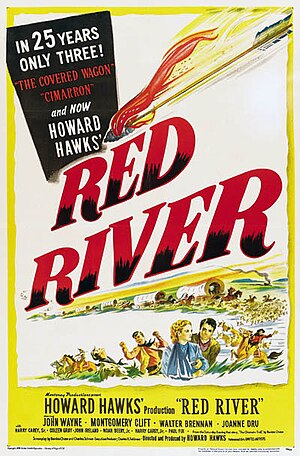Red River (1948 film)
Jump to navigation
Jump to search
| Red River (1948 film) | ||||||||||||||||||||||||||
|---|---|---|---|---|---|---|---|---|---|---|---|---|---|---|---|---|---|---|---|---|---|---|---|---|---|---|
This film has been preserved in the National Film Registry in 1990.
| ||||||||||||||||||||||||||
 | ||||||||||||||||||||||||||
|
Red River is a 1948 American western film directed and produced by Howard Hawks and starring John Wayne and Montgomery Clift, giving a fictional account of the first cattle drive from Texas to Kansas along the Chisholm Trail.
The film's based on a screenplay by Borden Chase and a subsequent published novel, which in turn is based on his serial "The Chisholm Trail", which was a fictional account of the first of the nation's great cattle drives.
Why It Rocks
- Interesting storyline where Tom Dunson and his adopted son Matthew Garth start a ranch in Texas, and Dunson’s at risk of losing everything unless he can find a market for his cattle forcing them to drive to Missouri. Garth joins the drive, in part to protect his own interests but takes the herd away from the increasingly tyrannical Dunson halfway through and heads off to Abilene, Kansas, where Garth faces Dunson in a showdown. (Although there are some flaws and drawbacks in the storyline for reasons listed below.
- The screenplay’s mostly faithful to Borden Chase’s serial and novel, which serves as a fictional account of the first of the nation’s great cattle drives. In addition to that, the changes made for the film’s screenplay works out very well, such as adding a prologue and revising the ending.
- It's one of the most recognized and complex westerns of its era, and it's noticeably more ambitious and serious than the majority of Howard Hawks' films, especially his later work.
- Excellent performances from the cast that help to enhance the portrayals in comparison with the novel.
- John Wayne was at the time actor from mid-tier Westerns and war movies, as such no one expected that he’d be able to deliver a nuanced and unvarnished and version of Dunson, with such as fearless performance
- Montgomery Clift in his screen debut, particularly played a memorable character, Matthew Garth who eventually rebelled against Dunson's tyranny and became his most formidable rival.
- Additional cast members give good performances as well – considering they’re regulars for Hawks – such as Walter Brennan, Noah Beery Jr, and true Western icon Harry Carey Sr. (although this would be one of his last film appearances). It should also be noted that this is the sole film where Harry Carey Sr. appeared with his son, Harry Carey Jr., even if they didn’t share any scenes together.
- Incredible black-and-white cinematography by Russell Harlan with the shooting mostly taking place in Arizona, with the interiors shot in Hollywood.
Bad Qualities
- The ending is considered one of the film’s weakest aspects. Aside from it being nearly identical to The Outlaw, on which he also worked on, the big showdown the entire movie was building up for is a major letdown considering Dunson and Garth acted out a fierce psychological rivalry for two hours (and 14 years timewise) during the film, only to cave in instantly to Tess breaking the fight up. Even Howard Hawks himself has a problem with the film’s ending.
- The use of back projection in some of the dialogue exchanges can be pretty glaring the distracting.
- The fact that the same mountain can be seen on the horizon throughout the drive may come across as fairly obvious to modern viewers and it makes it seem like there's very little space to film.
- Tess' characterization is uneven and shaky.
- The way the film relied on the cattle drive itself to provide a story line, is perhaps the film's most glaring flaw. In various other western works, a cattle drive provides a background to compelling dramatic incidents taking place in the foreground. The nuts and bolts of actual cattle drives aren't very interesting, so one could be forgiven if they found the film dull and certain areas.